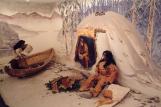10
The White River AshAbout 1200 years ago, central and southern Yukon was covered with volcanic ash from the eruption of Mount Churchill near the Alaska/Yukon border. Today, the ash from this eruption (called the White River Ash) can be seen below the topsoil as a white layer that is around 10 cm thick. This is a very valuable dating tool for archaeologists. If they find an artifact below the ash, they automatically know that it is over 1200 years old. If the artifact is above the ash, it must be more recent.
We can only guess what effect the ash-fall had on the people of that time. The animals, fish and plants may have died off. According to knowledge passed down to Elders Susie Skookum and Violet Johnny, the ash covered the tents like snow, and burned when you touched it. People had to go and sit in the water then.
Some think that Yukon people may have fled their homeland to escape the effects of the ash. Today's Navajo and Apache people of the southwestern United States speak a very similar language to Northern Tutchone. According to Elders, these people are the descendants of the people who fled the Yukon after the ash fall.
11
Diorama of life during the White River Ash fall, Tagé Cho Hudän Interpretive Centre1980
Carmacks, Yukon
 Credits:
Credits:(Courtesy LSCFN)